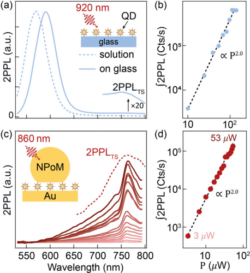Plasmon-Induced Trap State Emission from Single Quantum Dots
In this paper we embed quantum dots (QD) into extremely small optical cavities called ‘plasmonic nanocavities’. These are constructed using low-cost self-assembly but are extremely reliable in resonant wavelength and how tightly the light is trapped, many millions of times tighter the best optical cavities made from conventional mirrors or waveguides. We show that the QD emission from these plasmonic nanocavities is rather different from their normal emission. In particular light from electronic trap states which is normally inefficient becomes extremely strong. This gives new insights into how electrons relax in such quantum dots in the vicinity of metal contacts. In final devices these metal contacts are used to excite the QD light emission. In these experiments, very weak excitation of the QDs is used, at photon energies normally too small to excite the electrons. However, the light is trapped so tightly in these nanoscale gaps between Au facets that two photons can be absorbed at once (since they are more often in the same location). The excitation is efficient but gives a different luminescence emission spectrum than normal excitation. We show that the quantum mechanical selection rules are important, and that a new relaxation path for the electrons exists. It delivers the electrons into trap states on the QD surfaces, that the plasmonic nanocavity now causes to emit efficiently.  This opens a new route to making compact emitters, since the surface states are normally non-emissive. The tailoring of the state in plasmonic nanocavities opens new directions to a whole class of different light emitters, beneficial to this project and its vision of creating self-assembled, chip-integrated light emitters. Figure shows two-photon excited photoluminescence (2PPL). (a) QD540 emission spectrum around 540 nm wavelength, excited by 120 fs pulses at 920 nm, for QDs in aqueous phase or air (dashed line) and dried on glass (solid line, as in inset). (b) Power dependence of 2PPL signals from QD540 solution, confirming emission is from two-photon absorption. (c) Emission spectra of QDs in a plasmonic nanocavity (as in inset) for increasing excitation power (solid line). Also shown (dashed line) is two-photon-absorption trap-state emission from QDs dried on glass. (d) Quadratic power dependence of QD PL in a plasmonic nanocavity.
This opens a new route to making compact emitters, since the surface states are normally non-emissive. The tailoring of the state in plasmonic nanocavities opens new directions to a whole class of different light emitters, beneficial to this project and its vision of creating self-assembled, chip-integrated light emitters. Figure shows two-photon excited photoluminescence (2PPL). (a) QD540 emission spectrum around 540 nm wavelength, excited by 120 fs pulses at 920 nm, for QDs in aqueous phase or air (dashed line) and dried on glass (solid line, as in inset). (b) Power dependence of 2PPL signals from QD540 solution, confirming emission is from two-photon absorption. (c) Emission spectra of QDs in a plasmonic nanocavity (as in inset) for increasing excitation power (solid line). Also shown (dashed line) is two-photon-absorption trap-state emission from QDs dried on glass. (d) Quadratic power dependence of QD PL in a plasmonic nanocavity.
About Author
 Jeremy John Baumberg, FRS, FInstP is Professor of Nanoscience in the Cavendish Laboratory at the University of Cambridge, a Fellow of Jesus College, Cambridge and Director of the NanoPhotonics Centre.
Jeremy John Baumberg, FRS, FInstP is Professor of Nanoscience in the Cavendish Laboratory at the University of Cambridge, a Fellow of Jesus College, Cambridge and Director of the NanoPhotonics Centre.